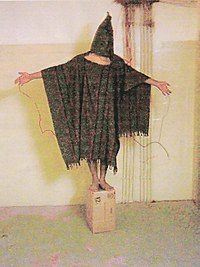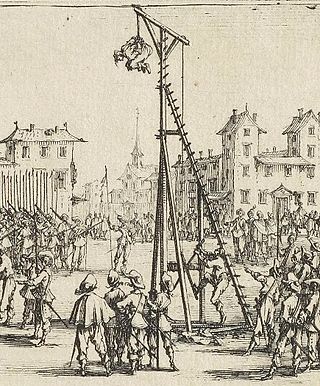
The strappado, also known as corda, is a form of torture in which the victim's hands are tied behind their back and the victim is suspended by a rope attached to the wrists, typically resulting in dislocated shoulders. Weights may be added to the body to intensify the effect and increase the pain. This kind of torture would generally not last more than an hour without rest, as it would otherwise likely result in death.

During the early stages of the Iraq War, members of the United States Army and the Central Intelligence Agency committed a series of human rights violations and war crimes against detainees in the Abu Ghraib prison in Iraq, including physical abuse, sexual humiliation, both physical and psychological torture, rape, as well the killing of Manadel al-Jamadi and the desecration of his body. The abuses came to public attention with the publication of photographs of the abuse by CBS News in April 2004. The incidents caused shock and outrage, receiving widespread condemnation within the United States and internationally.
About six months after the United States invasion of Iraq of 2003, rumors of Iraq prison abuse scandals started to emerge.
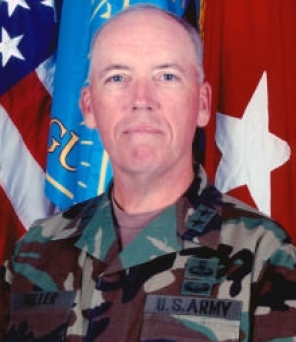
Geoffrey D. Miller is a retired United States Army major general who commanded the US detention facilities at Guantanamo Bay, Cuba, and Iraq. Detention facilities in Iraq under his command included Abu Ghraib prison, Camp Cropper, and Camp Bucca. He is noted for having trained soldiers in using torture, or "enhanced interrogation techniques" in US euphemism, and for carrying out the "First Special Interrogation Plan," signed by the Secretary of Defense, against a Guantanamo detainee.
Medical torture describes the involvement of, or sometimes instigation by, medical personnel in acts of torture, either to judge what victims can endure, to apply treatments which will enhance torture, or as torturers in their own right. Medical torture overlaps with medical interrogation if it involves the use of professional medical expertise to facilitate interrogation or corporal punishment, in the conduct of torturous human experimentation or in providing professional medical sanction and approval for the torture of prisoners. Medical torture also covers torturous scientific experimentation upon unwilling human subjects.
Torture, the infliction of severe physical or psychological pain upon an individual to extract information or a confession, or as an illicit extrajudicial punishment, is prohibited by international law and is illegal in most countries. However, it is still used by many governments. The subject of this article is the use of torture since the adoption of the 1948 Universal Declaration of Human Rights (UDHR), which prohibited it.
Ghost detainee is a term used in the executive branch of the United States government to designate a person held in a detention center, whose identity has been hidden by keeping them unregistered and therefore anonymous. Such uses arose as the Bush administration initiated the War on Terror following the 9/11 attacks of 2001 in the United States. As documented in the 2004 Taguba Report, it was used in the same manner by United States officials and contractors of the Joint Interrogation and Debriefing Center at the Abu Ghraib prison in Iraq in 2003–2004.
Far' Falastine, also known as Branch 235, is a prison operated by Syrian Intelligence under the charge of Brig. Gen. Muhammad Khallouf located in Damascus, notorious for accounts of torture, coercive interrogation, and deplorable conditions related by its former detainees.
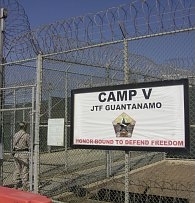
The Guantanamo Bay detention camp is a United States military prison within the Guantanamo Bay Naval Base, also referred to as Gitmo, on the coast of Guantánamo Bay in Cuba. As of March 2022, of the 780 people detained there since January 2002 when the military prison first opened after the September 11 attacks, 741 had been transferred elsewhere, 30 remained there, and 9 had died while in custody.
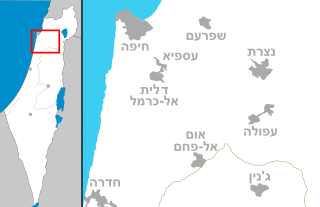
Camp 1391 or Unit 1391 or Facility 1391 is an Israel Defense Forces prison camp in northern Israel for "high-risk" prisoners. It is run by Unit 504. The existence of the prison was unknown to the public before 2003, and most information about it remains classified, though Israel's supreme court ordered the release of some information about the jail.
Baha Mousa was an Iraqi man who died while in British Army custody in Basra, Iraq in September 2003. The inquiry into his death found that Mousa's death was caused by "factors including lack of food and water, heat, exhaustion, fear, previous injuries and the hooding and stress positions used by British troops - and a final struggle with his guards". The inquiry heard that Mousa was hooded for almost 24 hours during his 36 hours of custody by the 1st Battalion of the Queen's Lancashire Regiment and that he suffered at least 93 injuries before his death. The report later details that Mousa was subject to several practices banned under both domestic law and the Geneva Conventions. Seven British soldiers were charged in connection with the case. Six were found not guilty. Corporal Donald Payne pleaded guilty to inhumane treatment of a prisoner and was jailed for a year and dismissed from the Army. On 19 September 2006 with his guilty plea to inhumane treatment of Mousa, Payne became the first British soldier to admit to a war crime.
There are cases, both documented and alleged, that involve the usage of torture by members of the United States government, military, law enforcement agencies, intelligence agencies, health care services, and other public organizations both in and out of the country.
"Enhanced interrogation techniques" or "enhanced interrogation" was a program of systematic torture of detainees by the Central Intelligence Agency (CIA), the Defense Intelligence Agency (DIA) and various components of the U.S. Armed Forces at remote sites around the world—including Bagram, Guantanamo Bay, Abu Ghraib, and Bucharest—authorized by officials of the George W. Bush administration. Methods used included beating, binding in contorted stress positions, hooding, subjection to deafening noise, sleep disruption, sleep deprivation to the point of hallucination, deprivation of food, drink, and medical care for wounds, as well as waterboarding, walling, sexual humiliation, rape, sexual assault, subjection to extreme heat or extreme cold, and confinement in small coffin-like boxes. A Guantanamo inmate's drawings of some of these tortures, to which he himself was subjected, were published in The New York Times. Some of these techniques fall under the category known as "white room torture". Several detainees endured medically unnecessary "rectal rehydration", "rectal fluid resuscitation", and "rectal feeding". In addition to brutalizing detainees, there were threats to their families such as threats to harm children, and threats to sexually abuse or to cut the throat of detainees' mothers.
The future of Palestinian prisoners detained by Israel in the context of the Israeli–Palestinian conflict is considered central to progress in the Israeli–Palestinian peace process. Cases of prison sentences include the charges of terrorism or being a member of an "illegal terrorist organization", such as Hamas or prior to the Oslo Accords the Palestine Liberation Organization, but according to some accounts also by political activism such as raising a Palestinian flag.
The Public Committee Against Torture in Israel is an Israeli NGO established in 1990 that monitors the use of torture and ill-treatment by Israeli security services against Palestinians under detention. PCATI was founded in 1990 in reaction to what it describes as "the ongoing policy of the Israeli government, which permitted the systematic use of torture and ill treatment in Shin Bet interrogations".
The widespread and systematic use of torture in Turkey goes back to the Ottoman Empire. After the foundation of the Republic of Turkey, torture of civilians by the Turkish Armed Forces was widespread during the Dersim rebellion. The Sansaryan Han police headquarters and Harbiye Military Prison in Istanbul became known for torture in the 1940s. Amnesty International (AI) first documented Turkish torture after the 1971 Turkish coup d'état and has continued to issue critical reports, particularly after the outbreak of the Kurdish-Turkish conflict in the 1980s. The Committee for the Prevention of Torture has issued critical reports on the extent of torture in Turkey since the 1990s. The Stockholm Center for Freedom published a report entitled Mass Torture and Ill-Treatment in Turkey in June 2017. The Human Rights Foundation of Turkey estimates there are around one million victims of torture in Turkey.

The Landau Commission was a three-man Commission set up by the Israeli Government in 1987 following a long-running scandal over the deaths of two Palestinian prisoners in custody and the wrongful conviction of a Circassian IDF officer. The Commission, headed by former Supreme Court Justice Moshe Landau, found that the GSS interrogators routinely used physical force during the interrogation of prisoners and then committed perjury at subsequent trials. In its conclusion, approved by Cabinet in November 1987, it lay down guidelines for the use of a "moderate measure of physical pressure". The details of the recommended methods were described in the classified appendix to the report. In 1994 the UN Committee Against Torture stated: "The Landau Commission Report, permitting as it does 'moderate physical pressure' as a lawful mode of interrogation, is completely unacceptable to this Committee."
The Al-Moskobiya, Moscobiyeh, Muscovite or Moscovia Detention Centre is an Israeli detention and interrogation facility and prison more commonly known as The Russian Compound, located in West Jerusalem. The center is used to interrogate Palestinian detainees and prisoners from a variety of age groups, including children. The Palestinian NGO Addameer has alleged that harsh methods of torture are used there.
Israeli torture in the occupied territories refers to the use of torture and systematic degrading practices on Palestinians detained by Israeli forces in both the West Bank and the Gaza Strip. The practice, routine for decades, was eventually reviewed in the Supreme Court of Israel (1999) which found that "coercive interrogation" of Palestinians had been widespread, and deemed it unlawful, though permissible in certain cases. Torture is also practiced by the Palestinian authorities in the West Bank and the Gaza Strip.
Since the outbreak of the 2023 Israel–Hamas war on October 7, Israel has carried out mass arrests and detentions of Palestinians, with thousands arrested or detained in Israel and the occupied Palestinian territories. News outlets and human rights organizations both within and outside of Israel reported that thousands of Gazan workers in Israel were detained or disappeared in the weeks following October 7. Additionally, Israel has carried out mass arrests in the occupied West Bank, detained Palestinian fighters captured inside Israel, and arrested Palestinian citizens of Israel. Concerns have been raised regarding the legality, secrecy, and conditions of many detentions, including widespread mistreatment and allegations of torture.
